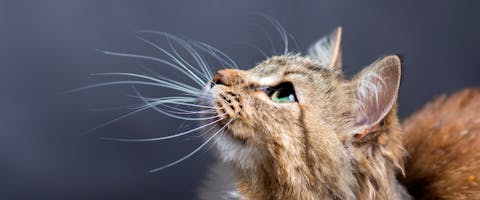Whiskers aren’t just a fancy feline feature, and from mustache-like marvels to elegant eyebrow-esque strands, these super-sensitive instruments do more than just sit pretty on your kitty’s face. So, what in the world are cat whiskers, and why do our feline friends have them?!
What are cat whiskers?
If you thought cat whiskers were kind of like hair, then you’re on the right track. Just like human hair, cat whiskers are made from keratin, but they’re much longer and thicker than your average strand of hair. They sprout from hair follicles but their roots go three times deeper than regular hair, meaning they’re much better at staying put.
Unlike normal hairs, whiskers are very particular about where they grow. Depending on the cat breed, they’re likely to be found above the eyes, on the cheeks, and along the back of the front legs.
Trending posts
Purr-use some of the top blogs our members have been loving this month- Top male dog names for your new furry friendGot a new furry family member in your pack? Check…

- Top female dog names for your new fluffy palWelcoming a new pooch into your family? Explore…

- 250+ gray cat names your silver feline will loveRecently welcomed a fluffy gray bundle of joy into…

- What are normal pet sitting rates?Discover the average pet sitting rates for animals…

- Unique dog names to stand out from the packDare to be different with our list of the best…

Why do cats have whiskers?
So what are cat’s whiskers for? Full of sensitive nerve endings much like human fingertips, whiskers act as a cat’s personal set of feelers. But “touching” something with whiskers isn’t quite the same as touching it with a human’s fingertips – let’s take a closer look at a cat whisker’s purpose.
To understand their environment
Cats don’t have the best eyesight, and they find it particularly hard to focus on things up close or in low-light conditions. That’s where their whiskers come to the rescue!
Cats use their whiskers to detect changes in air currents, which send messages to the brain about an object’s size and its proximity to them. In the wild, this would have been useful for both hunting and hiding from predators, and at home, it helps them to find things like their food and water bowls under cover of darkness. So while cats can’t “see” with their whiskers in the sense we know it, they use them to learn more about their environment.
For balance
At the base of each whisker is a tiny sensory organ called a proprioceptor, which sends information to the cat’s brain about the position and movement of its body. This helps cats to coordinate their movements with incredible precision, and explains why cats are so good at landing on their feet!
To show their feelings
Watch those whiskers to catch a glimpse of your cat’s mood! If your furry friend’s feeling relaxed, their whiskers will show it by drooping downwards. If something piques their interest, their whiskers might perk up in the kitty’s version of a raised eyebrow. And if your cat feels threatened, those whiskers will pull back and hug their face in caution.
For protection
Just as human eyebrows protect our eyes from dust and debris, whiskers can protect a cat’s eyes against anything nasty. But that’s not all – these savvy sensors can also prevent your cat from getting too close to anything unpleasant – like a prickly thorn bush. When it comes to squeezing through tight spots, cats also use their whiskers a bit like a measuring tape to asses whether their body will fit. So if you were wondering “Why are my cat's whiskers so long”, there’s your answer!
Has all this talk of cat whiskers whisked your curiosity about cat sitting to new heights? Put your newfound whisker wisdom to good use and discover house and pet sitting opportunities all over the world! From cozy cottages in the countryside to bustling city apartments, enjoy the adventure of a lifetime as you exchange loving pet care for a place to stay.
The wonders of cat whiskers - FAQs
Do cats shed whiskers?
Just like losing their fur, cats also shed their whiskers every now and again. However, if you notice more than a couple cat whiskers falling out at a time, then this could be cause for concern. Allergies, infections, trauma, and acne can all cause your furry friend to lose more whiskers than normal, so speak to your vet if you notice anything out of the ordinary.
Do cat whiskers grow back?
Yes, cat whiskers usually grow back within a couple of months, as long as the hair follicle hasn’t been damaged.
Can you cut cat whiskers?
Cat whiskers should not be cut or trimmed unless your vet tells you to do so because of medical issues. Whiskers are an important way to navigate the world for cats, and should be left well alone.
What happens if you cut a cat's whiskers?
Never give your cat a whisker trim unless your vet instructs you to do so for a medical reason. Rather like our fingertips, cats use their whiskers to understand the world around them – imagine if someone snipped off your fingers!
How many whiskers does a cat have?
Most cats have around 24 whiskers on their face with a couple dangling over each eye and the rest protruding from their cheeks. They also have whiskers that run along their forelegs.

